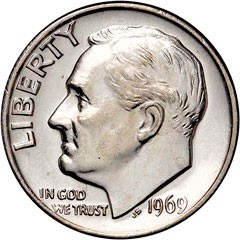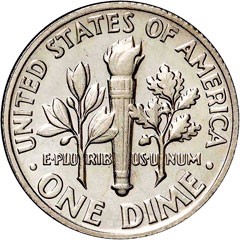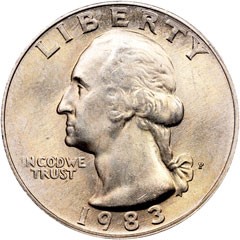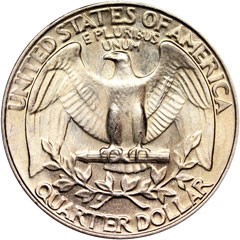USA Coin Album: America’s Neglected Coins
Posted on 12/8/2020
The removal of silver from America’s coinage occurred right about the time I was starting to seek those very coins to fill my blue folders. Within a couple of years, the dimes and quarters dated 1964 or earlier had nearly disappeared, and I rarely saw any of these pieces in circulation after 1968. This had a devastating effect on the popularity of collecting coins from pocket change and bank rolls, an activity that has never really regained its old status.
The first copper-nickel-clad coins that replaced the silver pieces are now more than 50 years old, and yet the urge to complete folders with them doesn’t seem to exist. In the mid-1960s, when silver coins were still the norm, the chance of finding any pieces more than 25 to 30 years old was fairly slim, so why aren’t the clad coins deemed collectible? Many of the dimes and quarters coined in the 1960s and '70s are now rather difficult to find in change, but few people are taking up that challenge. The fact that clad coins are not especially attractive to the eye in worn condition does limit their aesthetic appeal. Silver coins acquired toning in their recessed areas, while their relief elements retained a contrasting lighter color that gave them a certain cameo quality. Clad coins, however, just become uniformly dull in circulation, so the idea of putting them into folders and albums just isn’t quite as compelling.
I suspect that the emphasis on high grades that dominates the hobby these days plays a strong part in discouraging this activity. The collectors who are seeking clad coins want only those pieces that can be competitive in the online registries, such as the NGC Registry. This is evident in the typically low values for Mint State coins certified as less than MS 65.
There are just a few instances of clad coins having premium values in less than gem condition. Despite their high mintages, the quite poorly made quarter dollars dated 1982 and 1983 from both mints bring fairly strong prices in any MS grade, yet these same issues are worth just face value in any circulated grade. Yes, the US Mint suspended its sales of Uncirculated Sets during those years, but are these four coins really rare? If so, then they should be collectible in the grades of About Uncirculated and Extremely Fine, yet no premium applies.
Indeed, there appears to be no premium value at all for even the most elusive clad coins in less than Mint State grades. This represents a major cultural shift in the American coin hobby from 1965 to the present. In that earlier time, most collectors acquired as many coins as they could from circulation, purchasing from dealers only those they could not find. I’ve bought a number of old-time collections for the sole purpose of obtaining rare or desirable folders and albums, which I collect more so than the coins. In my experience, it is very common to find the key and semi-key coins in Mint State condition, while all of the lesser issues are in various circulated grades.
Looking back on my own early days in the hobby, I followed this same course. For example, I obtained nearly all of the silver Roosevelt Dimes from circulation or by trading with my fellow collectors, but the widely hoarded 1949-50 issues eluded me. I bought those six coins from the Stamp and Coin Department of The Emporium in San Francisco, and all six were gleaming BU dimes that stood in stark contrast to my otherwise circulated collection. In later years, the incongruence of this situation compelled me to upgrade the entire set to Mint State and replace my humble folder with a deluxe album. This sort of progression seems to have been lost today, since budding collectors are bombarded by messages that only certified Mint State coins are worthy of their attention, and anything grading less than MS 65 is a waste of their money. Is it any wonder then that fewer people are drawn to the once pleasurable prospect of filling folders from pocket change?
I suppose such activity must still exist to some extent, because several brands of coin folders for current coin series remain in production. Who are these hearty folk who resist the siren call of certified coins? Are they old-timers who just won’t forsake the romance of collecting from circulation? Are they the grandchildren of those folks who are being guided toward the hobby in the hope that it will stick with them? It’s hard to say, but the fact that the coins still to be found in circulation have little prospect of ever being worth more than face value must inhibit the growth of coin collecting to some extent. This is quite unfortunate, as already there are many very elusive issues, such as the dimes and quarters dated 1969(P). I recall these being hard to find in circulation when new, and the passing of years has greatly reduced their numbers.
Unless the scarcer entries in these coin series begin to acquire some premium in circulated grades, there never will be a widespread urge to collect them. It’s hard to believe that coins more than 50 years old are worth only face value, yet this is something they have in common with most Jefferson Nickels, a series going back 80 years, and all Lincoln Memorial cents, a now obsolete series more than 60 years old.
David W. Lange's column, “USA Coin Album,” appears monthly in The Numismatist, the official publication of the American Numismatic Association.
Stay Informed
Want news like this delivered to your inbox once a month? Subscribe to the free NGC eNewsletter today!




